Report

한눈에 보기
- A rapidly expanding middle class in Asia-Pacific’s developing markets is triggering explosive demand for insurance.
- Deregulation in China, India and other markets has lifted barriers to foreign ownership, creating new openings for multinational insurers.
- In this sprawling, diverse region, insurers that prosper will develop a repeatable formula for success, venturing only into markets that align with their core strengths.
- Winners will understand the increasing importance of digital distribution, ecosystems and the customer experience.
Executive summary
A region rich with promise
Opportunities abound for insurers doing business in Asia-Pacific. In China, India and parts of Southeast Asia, households are accumulating wealth, and the middle class is expanding rapidly. Total household wealth in the region is on pace to outstrip North America’s by 2023, according to projections by Credit Suisse. In the same time frame, the number of middle-class households will reach 109 million in mainland China and 83 million in India, according to Euromonitor.
As people become wealthier, they spend more—both on necessities, such as food and shelter, and on discretionary items, such as motorcycles and cars. As households accumulate more possessions, they tend to buy more insurance, particularly for homes and vehicles. In mainland China, for example, premium income from general insurance rose at an average annual rate of 13% from 2013 to 2017, and could double between 2020 and 2029, according to a forecast by Swiss Re.
As living standards improve, so does access to medical care, spurring demand for health insurance. In many parts of Asia-Pacific, people are living longer and the population is aging, fueling the need for life insurance and related products that can help protect family living standards for the next generation. In the Chinese life insurance market, income from gross written premiums grew by about 25% annually from 2013 to 2017.
While these sociodemographic shifts are driving up insurance needs, coverage remains low. Consumers in Asia-Pacific’s developing markets are significantly underinsured. When it comes to life insurance, coverage often falls far short of the amount needed to replace household income in the event of the policyholder’s death. Collectively, 11 of the largest economies in Asia-Pacific were underprotected by around $58 trillion as of 2014, according to Swiss Re. Asians also aren’t saving enough for retirement, which means there is likely pent-up demand for the savings products sold by life insurers. Asia-Pacific households have set aside slightly more than half of the savings they will need for retirement, according to calculations by HSBC.
One measure of insurance penetration, gross written premiums as a percentage of per-capita GDP, signals a significant amount of unmet demand in Asia-Pacific’s developing markets. Penetration is less than 5% in India, Indonesia, mainland China and Malaysia, far below the rates in Hong Kong, Singapore and South Korea. Data from other developing markets shows that insurance purchases can increase dramatically as per-capita GDP rises.
Along with these promising demographic and macroeconomic trends, multinational insurers eager to expand in Asia-Pacific can also benefit from deregulation—particularly the easing of restrictions on foreign ownership of local insurers in mainland China, India and other markets.
Bain Partners Henrik Naujoks and Harshveer Singh discuss the most important success factors for companies competing in Asia's robust insurance market.
Navigating a diverse set of markets
The Asia-Pacific insurance market is not monolithic. Each country has unique characteristics, and there is no one-size-fits-all strategy for insurers operating across the region. Broadly speaking, Asia-Pacific life insurance and general insurance markets fall into four categories: booming giants (mainland China and India), dynamic developing markets (notably in Southeast Asia), mature markets (including Japan, South Korea and Australia), and hybrid markets (Hong Kong and Singapore). Even within each grouping, differences abound, meaning, for example, a strategy that works well in Indonesia won’t necessarily be effective in Malaysia.


In the rapidly growing Chinese market, large insurers such as Ping An, China Life, China Pacific and the People’s Insurance Company of China (PICC) hold commanding positions, which presents challenges for overseas insurers trying to make inroads. These domestic giants have focused on pursuing rapid top-line growth to gain market share, often at the expense of profit margins in the near term. The three major players in general insurance (PICC, Ping An and China Pacific) collectively have a 65% market share in automotive insurance, which accounts for 70% of all general insurance policies written in mainland China, mainly for individual customers. In life insurance, local players hold more than 90% of the market. Large domestic insurers such as China Life, Ping An and China Pacific are losing share to midsize domestic players.
In April 2018, China announced the gradual lifting of restrictions on foreign insurers, allowing companies that are 100% foreign-owned to operate in the country. Within seven months, Allianz received permission to set up a wholly owned insurance holding company in Shanghai. Soon after, AXA agreed to acquire the remaining 50% stake it did not already own in AXA Tianping Property & Casualty Insurance.
India is another large, rapidly growing market dominated by a handful of big companies. From 2013 to 2017, gross written premiums for general insurance grew at an annual rate of 15%, and direct written premiums for life insurance grew at a rate of 13%. Fast growth is likely to continue, due to rising incomes, increased consumer awareness of the value of insurance, high levels of urbanization, strong construction activity and frequent natural disasters. The market is relatively consolidated, with the top five players (New India, United India, National, ICICI Lombard and Oriental) accounting for 53% of the general insurance market and government-owned LIC controlling about 70% of the life market.
Reforms launched in India in 2015 have lifted the ceiling on foreign ownership of domestic insurers from 26% to 49%. In addition, the government has actively supported the microinsurance industry and has increased protections for consumers, by, for example, barring life insurers from unilaterally discontinuing coverage for customers who have held their policies for at least three years.
In the major developing markets of Southeast Asia, urbanization and population increases are driving strong demand for insurance. In Indonesia, gross written life insurance premiums grew at 11% annually from 2013 to 2017, but consumer awareness of the value of insurance remains low. The life insurance penetration rate (gross written premiums as a percentage of per-capita GDP) is about 2%. The general insurance market is highly fragmented, with the top five players accounting for just 35% of direct written premiums. Regulatory constraints limit foreign ownership to 80% of paid-in capital.
In the mature markets of Asia-Pacific, insurers must contend with slow growth or no growth. In Japan, net written life insurance premiums fell 1% per year from 2013 to 2017. Insurers are beset by an aging population, sluggish economic growth and near-zero bond yields. As the insured population becomes older and sicker, the underwriting risks increase, forcing Japanese insurers to look for profits from asset management and noninsurance investments. Japanese insurers spent about $18 billion in mergers and acquisitions in 2018.
In Australia, major banks have been offloading their insurance and wealth management businesses over the past two years due to lower-than-expected returns and changing regulations. The Royal Commission into Misconduct in the Banking, Superannuation and Financial Services Industry has recommended rules that will prohibit “hawking,” that is, the unsolicited selling of insurance products. The commission has also proposed restrictions on the incentives financial services companies can provide to employees for cross-selling products, which has prompted banks to pull back significantly on sales of insurance policies through their branch networks.
Two insurance markets in Asia-Pacific, Singapore and Hong Kong, are mature in some respects but still developing in others. Both markets are competitive and highly fragmented. In both markets, general insurance growth has been slow and steady, expanding about 1% per year from 2013 to 2017. By contrast, demand for life insurance, especially from the affluent segment, has been strong, with gross written premiums growing at 13% per year in Singapore and 15% in Hong Kong.
Digital first
Throughout Asia-Pacific, incumbent insurers looking to expand must contend with a distribution landscape that is being upended by advances in technology and the rise of digital-first competitors. In fast-growing markets such as mainland China, India and Indonesia, insurtechs and other new entrants—including technology firms, retailers and other companies from outside the industry—can leapfrog incumbents and gain market share.
Digital marketplaces, which allow customers to easily compare and select policies from competing carriers, threaten to take a significant share of the insurance profit pool. In major markets around the world, a majority of retail insurance customers—especially young, digitally active ones—are open to switching to another provider, including companies from outside the industry, such as retailers, automakers or tech firms, according to Bain & Company’s fourth global survey of more than 174,000 customers in 18 countries (“Customer Behavior and Loyalty in Insurance: Global Edition 2018”).
Asia-Pacific insurance consumers are exceedingly receptive to new ideas and new players. In Thailand, Indonesia, mainland China and Malaysia, for example, more than 85% are open to buying from new entrants, according to our survey.
Digital disruption is getting a push from regulators. In Singapore, Hong Kong and, more recently, Indonesia, authorities are actively promoting digital innovation and have established government-funded incubators, known locally as sandboxes, to encourage insurers to experiment with new technologies. Singapore and Hong Kong are emerging as hubs for telematics and insurtechs, and consumer use of digital channels in those markets is growing rapidly.
Venture capitalists have also recognized the potential profits to be made from digitally disrupting insurance. In the past five years, VCs have invested about $3.8 billion in Asia-Pacific insurtechs, including online sites that sell directly to the public, online brokers and advisers, and aggregators or digital marketplaces.
As the distribution landscape changes, some insurers are trying to gain an edge by bringing digital techniques such as advanced analytics and machine learning to bancassurance arrangements, whereby an insurer markets its products directly to a bank’s customers. Insurers and banks formed about 50 bancassurance agreements in Asia-Pacific in 2017 and 2018, in Nepal, India, Vietnam, Pakistan and other markets.
Developing a repeatable formula for success
Given the tremendous growth in many of Asia-Pacific’s developing markets, multinational insurers may be tempted to pursue a significant position in all of them. The logic goes like this: This is a hot market, it’s growing fast, profit margins are attractive, and if we want to succeed in the region, we need to be there. But such an approach can become a recipe for failure. Different markets have different characteristics and needs, and companies that feel compelled to overcustomize their strategies for individual Asia-Pacific markets often end up with high costs and few regional synergies.
The insurers that succeed in the region candidly assess their core capabilities and then invest in the markets that play to their strengths—while avoiding those that don’t. The key is to develop a repeatable formula that works across select markets. Part of this process involves deciding which markets to avoid. Mainland China and India, while rich in potential growth, may be too large and too complex for some multinationals. On the other end of the spectrum, mature markets such as Japan, Australia and South Korea may make sense only for multinationals with finely targeted expertise in a specialized area of insurance.
One major multinational insurer with a presence in three Asian markets recently reassessed its expansion strategy in the region. Instead of attempting to cover too many geographies, the company decided to focus on just five markets and invest primarily in two business lines—commercial insurance and retail automotive insurance—where it could quickly build scale. With automotive insurance, the repeatable formula would be extending and deepening the company’s relationships with vehicle manufacturers, importers, dealers and finance companies. With commercial insurance, the company would capitalize on its underwriting expertise with small and midsize enterprises, as well as its relationships with international brokers.
One key aspect of developing a repeatable formula is deciding which capabilities can be consolidated at regional headquarters and which should be cultivated in local markets. The multinational insurer recognized that it could achieve synergy across its Asia-Pacific markets by concentrating at the regional level its expertise in industry verticals, analytics and pricing models. It would also manage at the regional level its critical relationships with reinsurers. At the local level, the company would empower management teams to develop customized products and pricing, process claims and cultivate partnerships with auto dealers and other key players.
Embracing ecosystems
Across Asia-Pacific, insurers are embracing ecosystems, reimagining the value they deliver in auto, home, health and life insurance. The concept resonates with customers. About 90% of consumers surveyed by Bain & Company in the region are open to the idea of an ecosystem of services, and in many countries, a majority would like insurers to provide those services.
Chinese insurers have taken the lead in developing ecosystems. Ping An, for example, operates Good Doctor, a one-stop healthcare ecosystem with more than 50 million active users per month. Good Doctor’s services include treatment by family physicians, advice on healthy living and personal health management tools. The company aims to provide every member with a family doctor, an e-health profile and a healthcare management plan.
Ping An has also developed OneConnect, an ecosystem for small and midsize financial companies, including other insurers. OneConnect offers a cloud-based platform that uses artificial intelligence, blockchain and facial- and voice-recognition technologies. Insurers can use this platform to digitize core functions such as pricing and claims settlement.
Many insurers that don’t have their own ecosystems in Asia-Pacific are forming partnerships with those that do. In 2017 and 2018, more than 20 such agreements were struck in mainland China and Hong Kong. In some of these partnerships, established insurers joined with relatively young insurtechs. For example, AIA forged an agreement with WeDoctor, China’s leading technology-enabled healthcare platform, that will give AIA customers access to WeDoctor’s online appointment and advice services, as well as the ability to get treatment from WeDoctor’s network of 2,700 hospitals, 220,000 doctors and 15,000 pharmacies in 30 Chinese provinces.
Leading insurers see ecosystems as a way not only to generate growth but also to attract and retain customers. Throughout Asia-Pacific, customers who use and like ecosystems give their insurers the highest loyalty ratings, in both auto and life insurance, as measured by the Net Promoter Score®. Conversely, customers show the least loyalty to insurers that offer no ecosystem services at all.
Whether they choose to develop a new ecosystem or join an existing one in the region, insurers will face a series of critical, and often challenging, decisions. Bain’s experience shows that these strategic choices are best tackled early on. Once this key preparatory work has been done, companies can move swiftly to matters of design and operation (see Figure 1). It all begins with a three-pronged strategic approach:
- Define your role in the ecosystem. Given your specific position in the market in question, what are the opportunities to establish an ecosystem? Do you want to be a sole owner or a co-owner of the system, or would it make more sense to be a supplier, with no ownership stake? Would partnering with an insurtech or a noninsurance provider, such as a retailer or big tech firm, provide a new pool of customers or fresh data and insights?
- Select your target customers. Do you want to focus on your base of existing policyholders, or do you want to open your services and ecosystem fully or partially to prospects who are currently not, and may never be, policyholders?
- Clarify how to make money. Do you expect ecosystem offerings to cover their costs? Do you want them to generate a separate revenue stream? Determine what the economics of the ecosystem should look like for your company, customers and partners—at the outset and over time. (For more on insurance ecosystems, see the Bain Brief "Ecosystems: How Insurers Can Reinvent Customer Relationships.")


Prioritizing the customer experience
The dynamic nature of Asia-Pacific’s diverse insurance markets also creates opportunities for mergers and acquisitions, particularly in countries where growth has slowed and regulations have changed. Many of the recent large Asia-Pacific insurance transactions have involved the purchase of Australian life insurers by acquirers who want to expand into a major market.
In another slow-growth market, Japan, domestic insurers have adjusted to negative core underwriting margins by focusing on investment income. Many Japanese insurers are actively looking for returns by investing in other industries and by considering targets beyond Japan and the US, traditionally their two largest spheres of geographic interest.
Any insurer hoping to thrive in Asia-Pacific, whether by direct investment, ecosystem, partnership or M&A, must recognize the need to prioritize the customer experience. For several years now, insurers worldwide have been making efforts to become more customer-centric. Two trends are accentuating this phenomenon.
The first, digital expectations, is particularly significant in the developing markets of Asia-Pacific, where young, digitally active consumers make up a growing segment of the population. Customers now want to buy, manage and use their insurance in the same "simple and digital" ways that they use other financial products, such as credit cards and bank accounts. While customers still use a variety of online and offline channels, they are becoming increasingly comfortable with digital platforms—both unassisted and assisted, with the option to seek advice if necessary.
The other trend impelling the need for a sharper focus on the customer experience is the spread of regulations that grant new protections to consumers—as is evident in the antihawking recommendations of Australia’s Royal Commission.
In order to meet rising consumer expectations and increased regulatory scrutiny, forward-thinking insurers doing business in Asia-Pacific are taking a simple and digital approach to product design and the customer experience. That means creating simple propositions that offer value to customers and are easy to buy, especially via digital channels. It also means focusing on customers at the episode level, first by identifying pain points, such as complex products, burdensome processes, long wait times, lack of personalized service and advice, and limited transparency on the progress of orders, claims and requests for assistance.
Insurers that prosper in Asia will take a “today forward, future back” approach. Today forward means understanding customer expectations and global trends, and using state-of-the-art digital technology to make business better, cheaper and faster right now. Insurers typically focus on three to five well-defined initiatives that can get the company on a firm path to the future in each market where it does business. If today forward is made up of thoughtful doers, future back belongs to artful dreamers. They envision the future of insurance from the perspective of a technology-driven evolution of products and services. They imagine what insurance will look like 10 or 20 years from now, then work on steps today to prepare the company to compete in that world tomorrow.
In a time of disruption and in a region as dynamic and diverse as Asia-Pacific, winning insurers will develop a repeatable formula that is broad enough to play to their core strengths and specific enough to work in selected markets. They’ll consistently deliver quality at competitive prices and delight their customers in each and every episode, using a variety of channels, with a growing emphasis on digital. They’ll expand and intensify their connections—and maintain their command of the customer interface—by positioning themselves at the center of an ecosystem of services that meets their policyholders’ evolving needs.
1. The middle class is growing, and regulations are changing
- Asia-Pacific’s household wealth is growing, and its middle class is expanding, creating opportunities for insurers. The region’s household wealth is on pace to eclipse North America’s by 2023.
- A significant insurance gap exists in Asia-Pacific. Eleven of the largest economies in Asia-Pacific have a total life insurance gap of $58 trillion. People in the region are also undersaving for retirement.
- In Asia-Pacific’s developing markets, including India, Indonesia, mainland China and Malaysia, the rate of insurance penetration—gross written premiums as a percentage of per-capita GDP—indicates demand will rise.
- Throughout the region, regulatory changes are opening up markets. In 2018, China allowed 100% foreign-owned insurers to operate. In India, reforms initiated in 2015 have increased the maximum level of foreign ownership from 26% to 49%. And in India, Australia and elsewhere, regulators have introduced new protections for consumers of insurance.


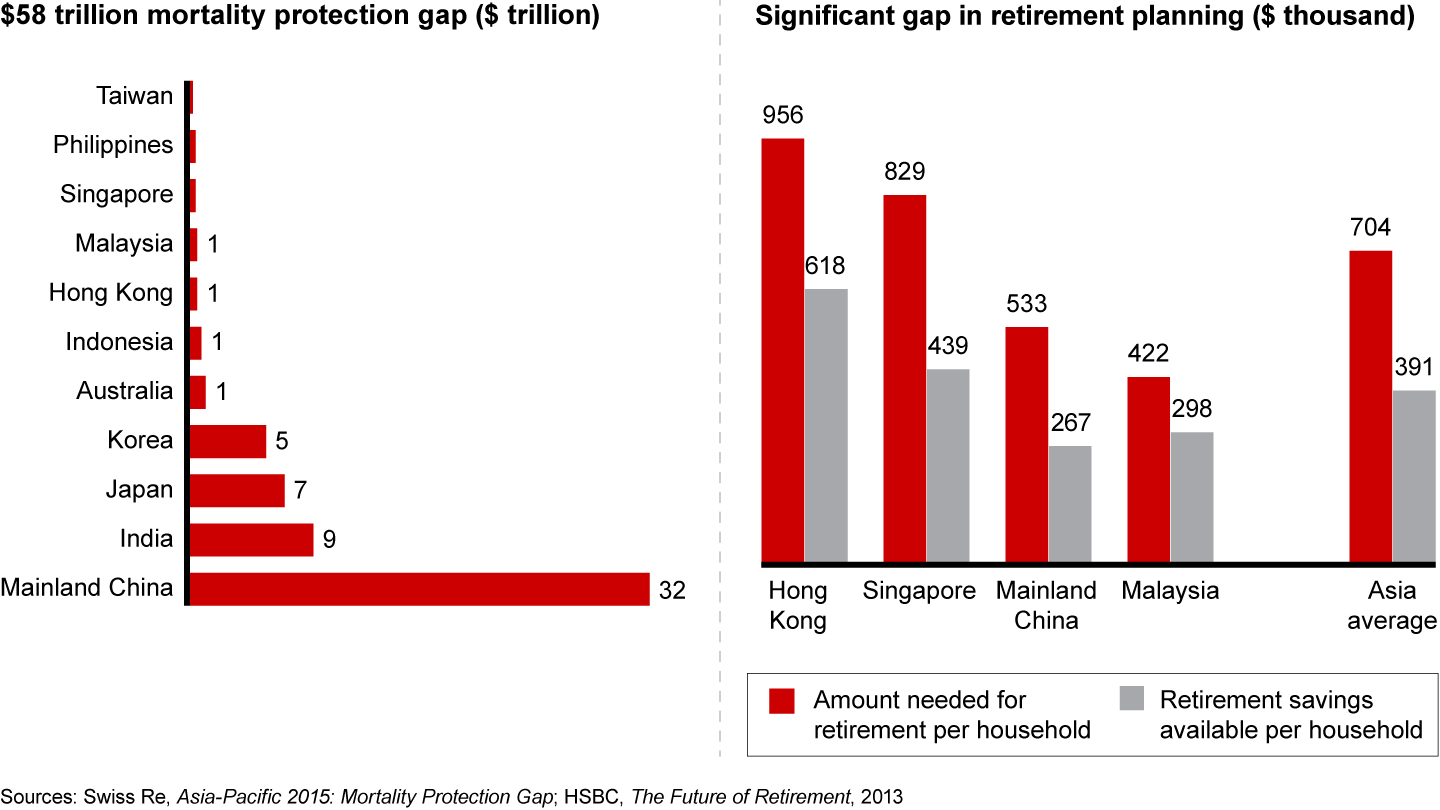

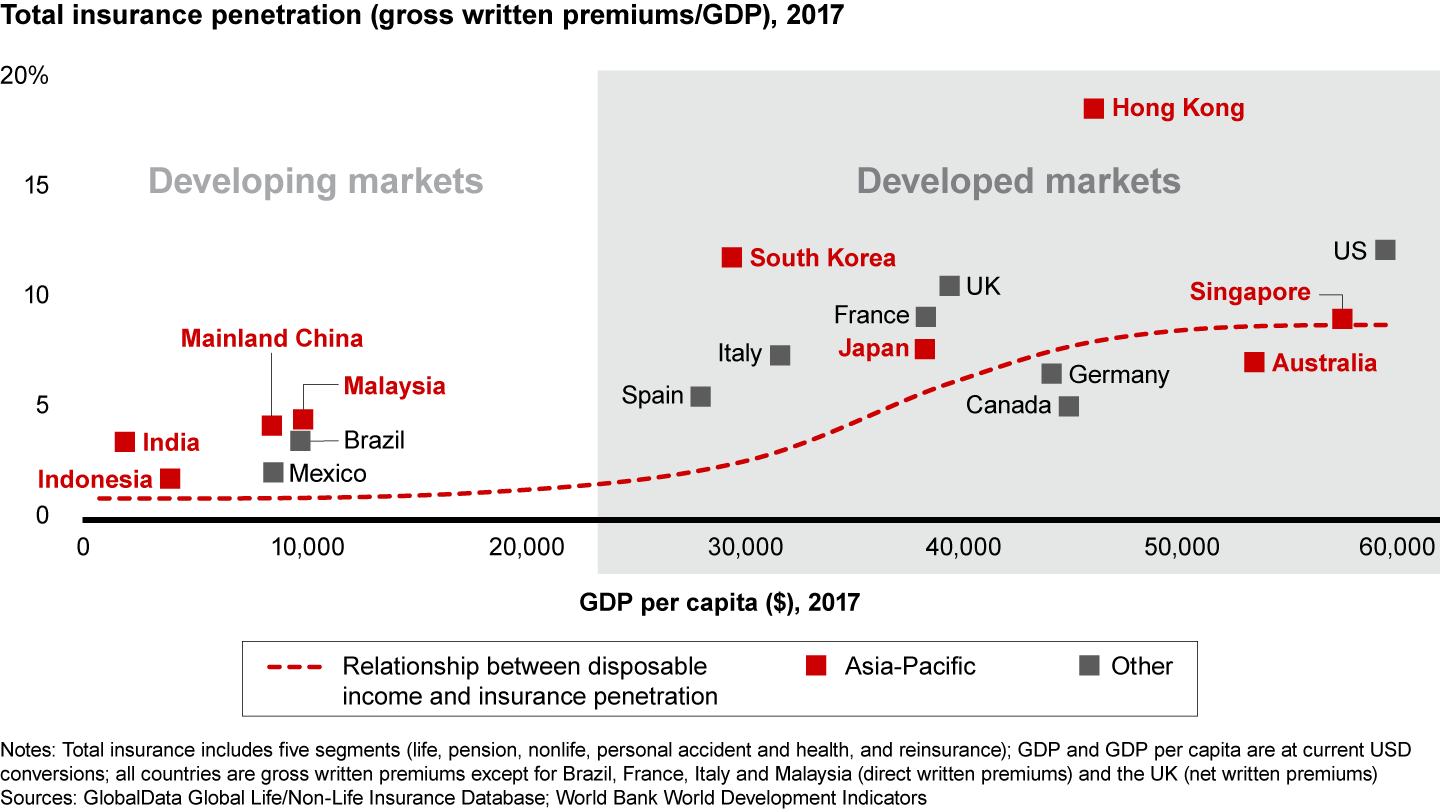

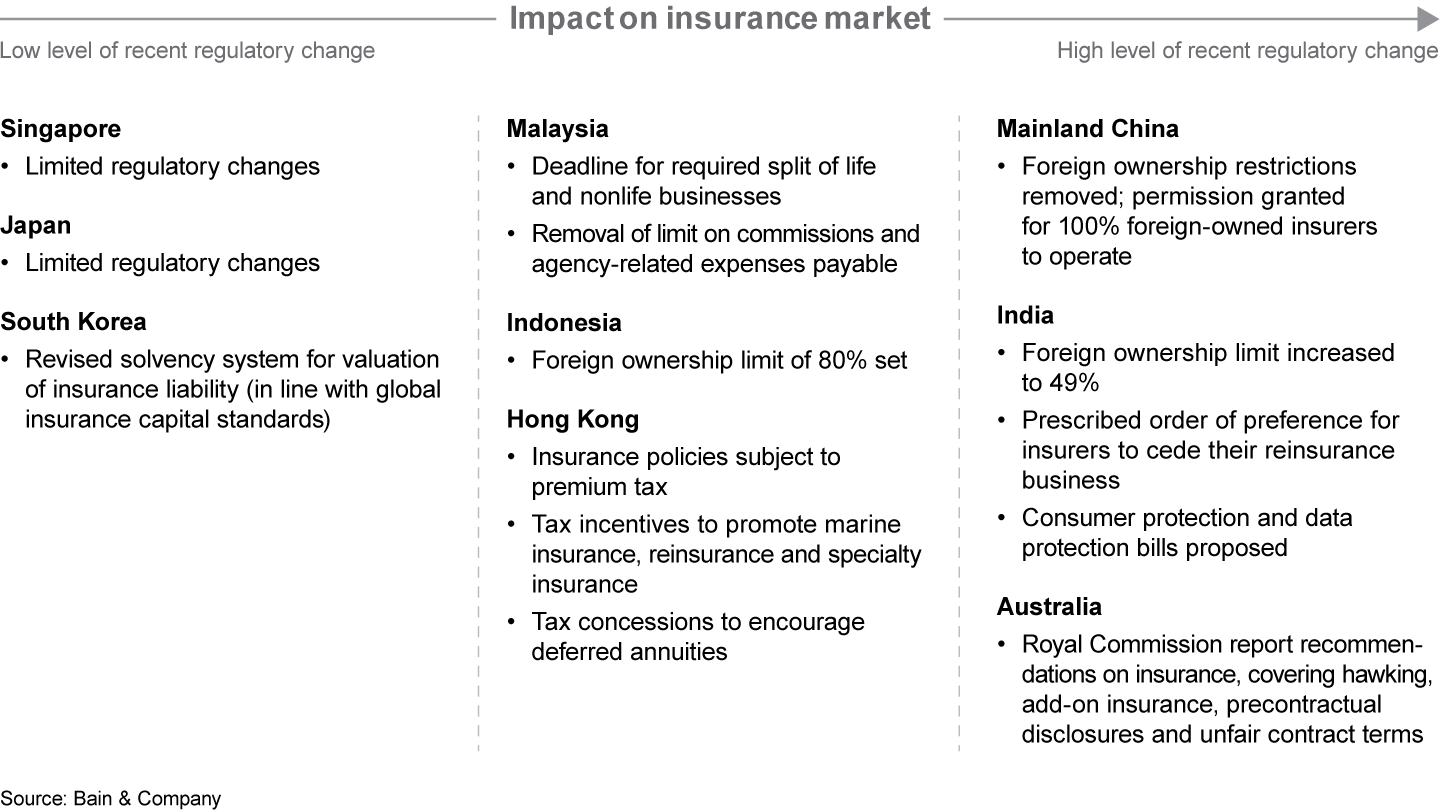

2. Distribution is becoming more digital
- The insurance distribution landscape is changing. In life insurance, traditional channels remain dominant in mature markets such as Australia, Hong Kong, Singapore and Japan, but in developing markets such as mainland China, India, Malaysia and Indonesia, digital channels are becoming more prominent.
- Since 2014, consumers in Asia-Pacific have increasingly used digital channels to buy general insurance policies.
- Customer preferences are pressuring insurers to prioritize digital. Across the region, consumers, particularly those who are young and digitally active, are open to buying insurance from new entrants, including ones from outside the industry.
- Venture capitalists have helped fuel the digital trend by raising $3.8 billion for Asia-Pacific insurtechs in the past five years. Chinese digital insurer ZhongAn, which has more than 400 million customers and went public in 2017, has raised about $2.4 billion. In India, digital marketplace Policybazaar has raised about $365 million in the same period.
- Multinational and domestic insurers are forming bancassurance agreements, mostly covering nonlife products, to gain access to the distribution networks of local banks, notably in Nepal and India. In Singapore, Chubb recently formed a bancassurance agreement with regional bank DBS to develop and test innovative microinsurance products, such as protection against cyber threats.
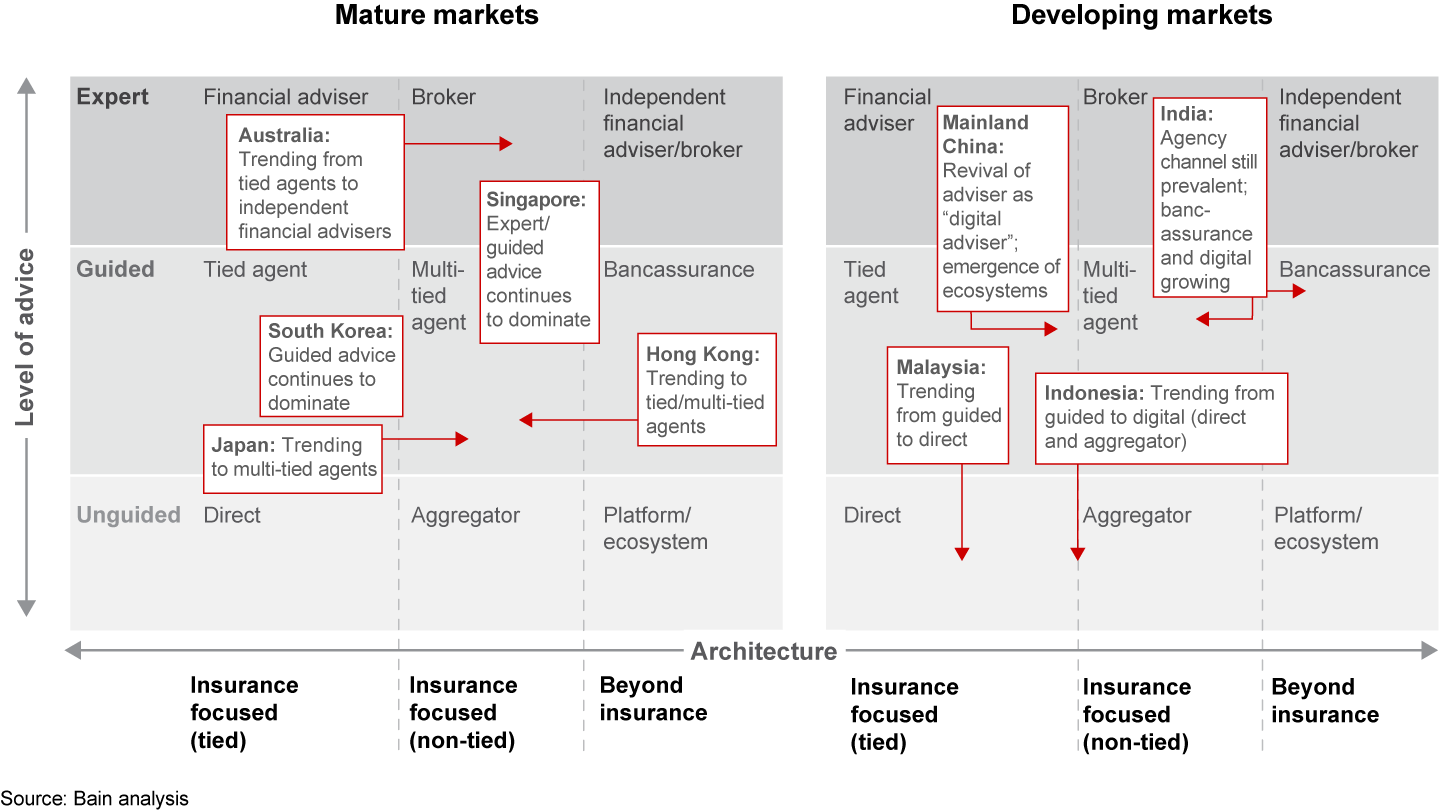



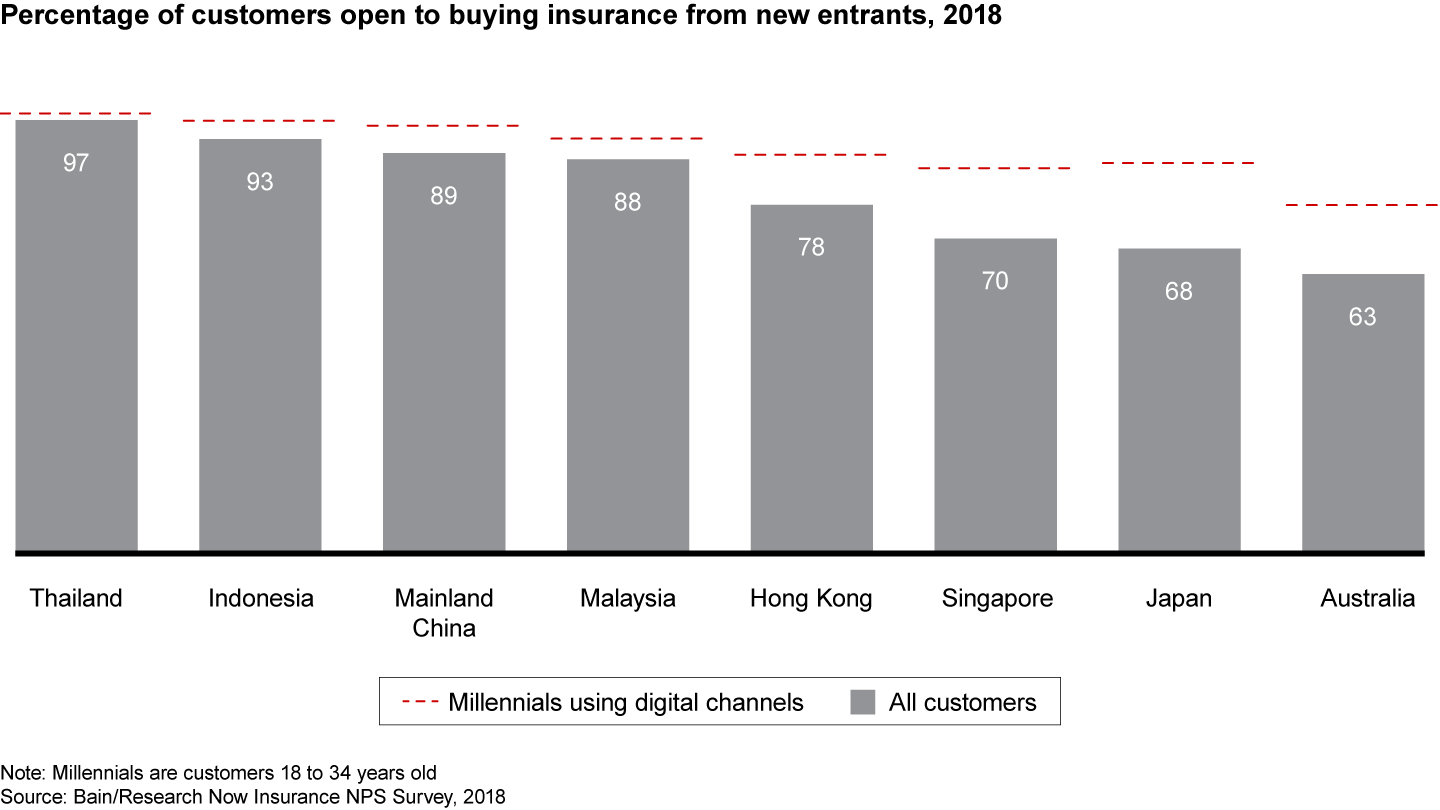

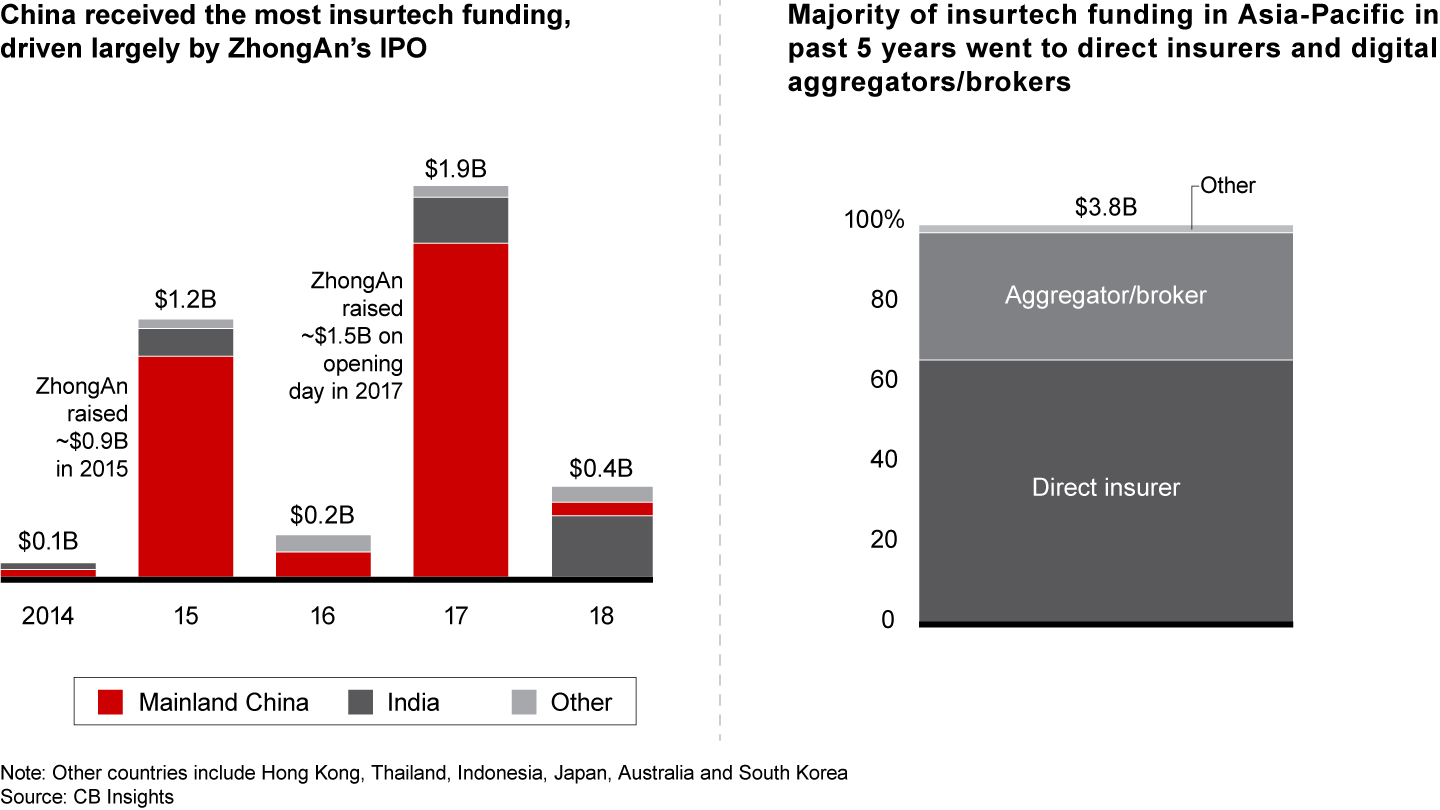

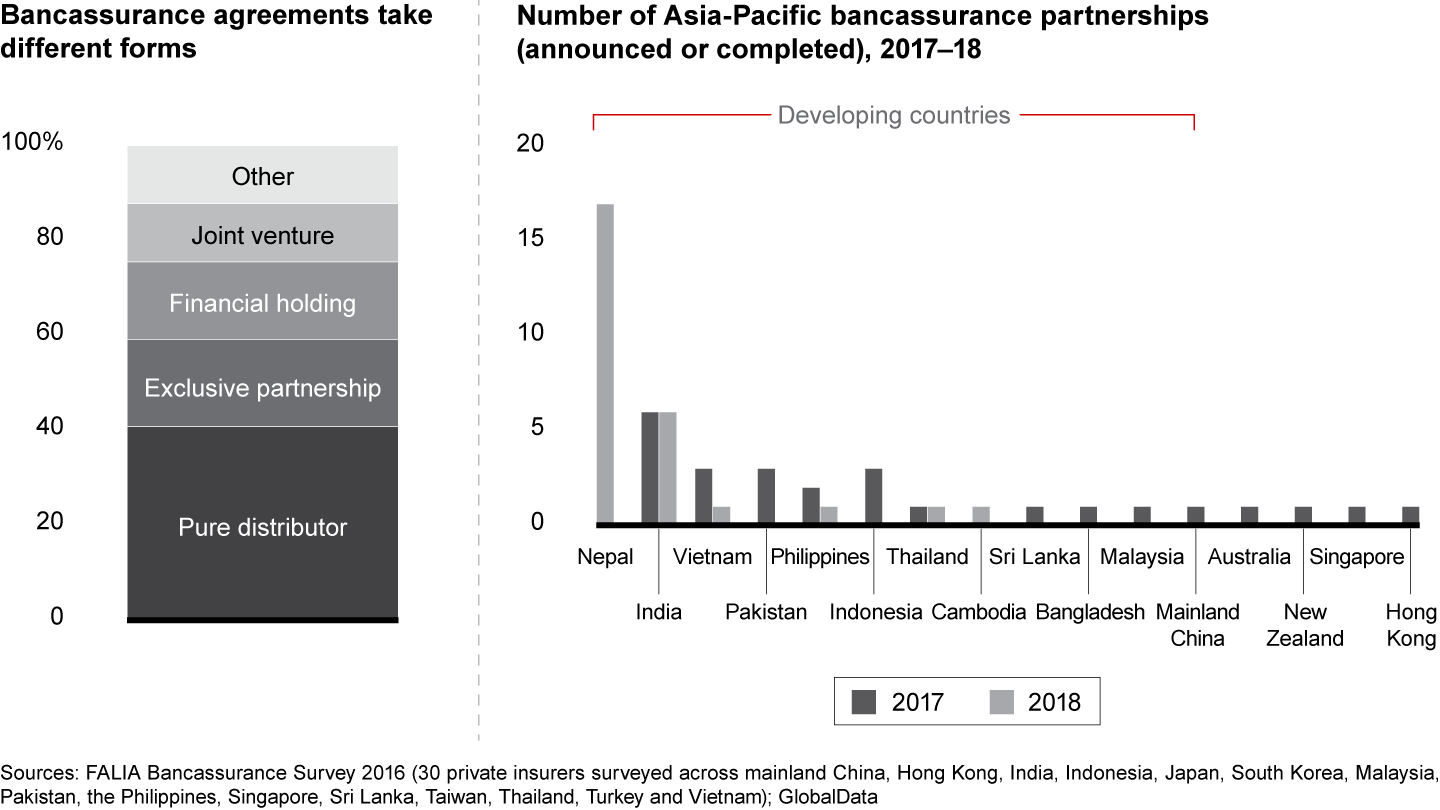

3. Ecosystems are taking hold
- Throughout Asia-Pacific, about 90% of consumers of automotive, home, health and life insurance are open to the idea of an ecosystem of services, and in many countries, a majority would like insurers to provide those services.
- By the widest margins among the three major regions of the world, Asia-Pacific customers who use and like ecosystem services give their insurers the highest loyalty ratings.
- The gap in loyalty ratings between those who use and like ecosystem services and those who don’t use ecosystem services at all is notable among life and auto insurance customers.
- Demand for ecosystem services has spurred new partnerships, as incumbent insurers seek to leverage capabilities developed by insurtechs, health providers, distributors and platform players. For example, AIA forged an agreement with WeDoctor, China’s leading technology-enabled healthcare platform, to give AIA customers access to WeDoctor’s online services and network of healthcare providers.
- In Australia, RACQ, an auto club and mutual organization, has developed an ecosystem that offers members insurance, roadside assistance, and travel, leisure and home repair services.
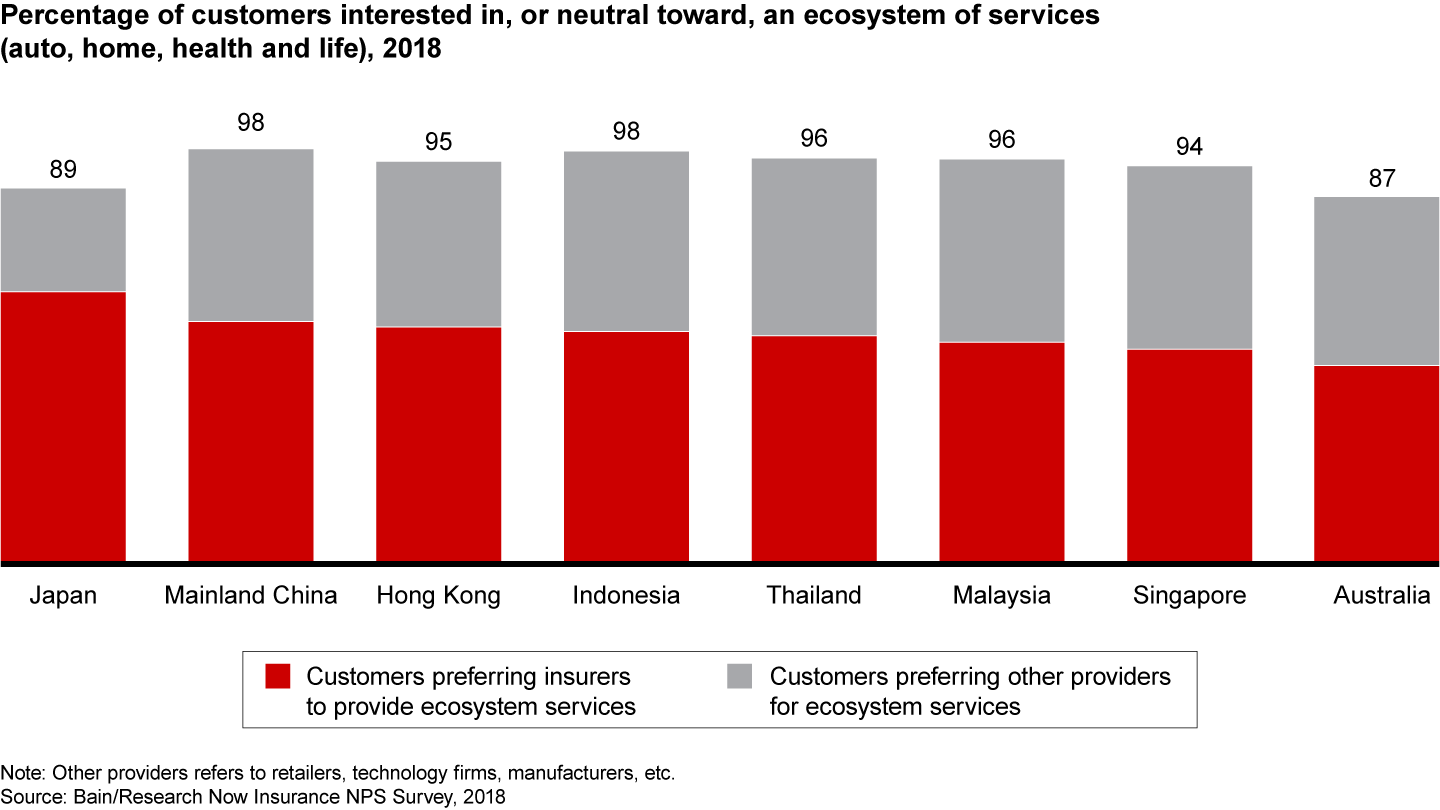

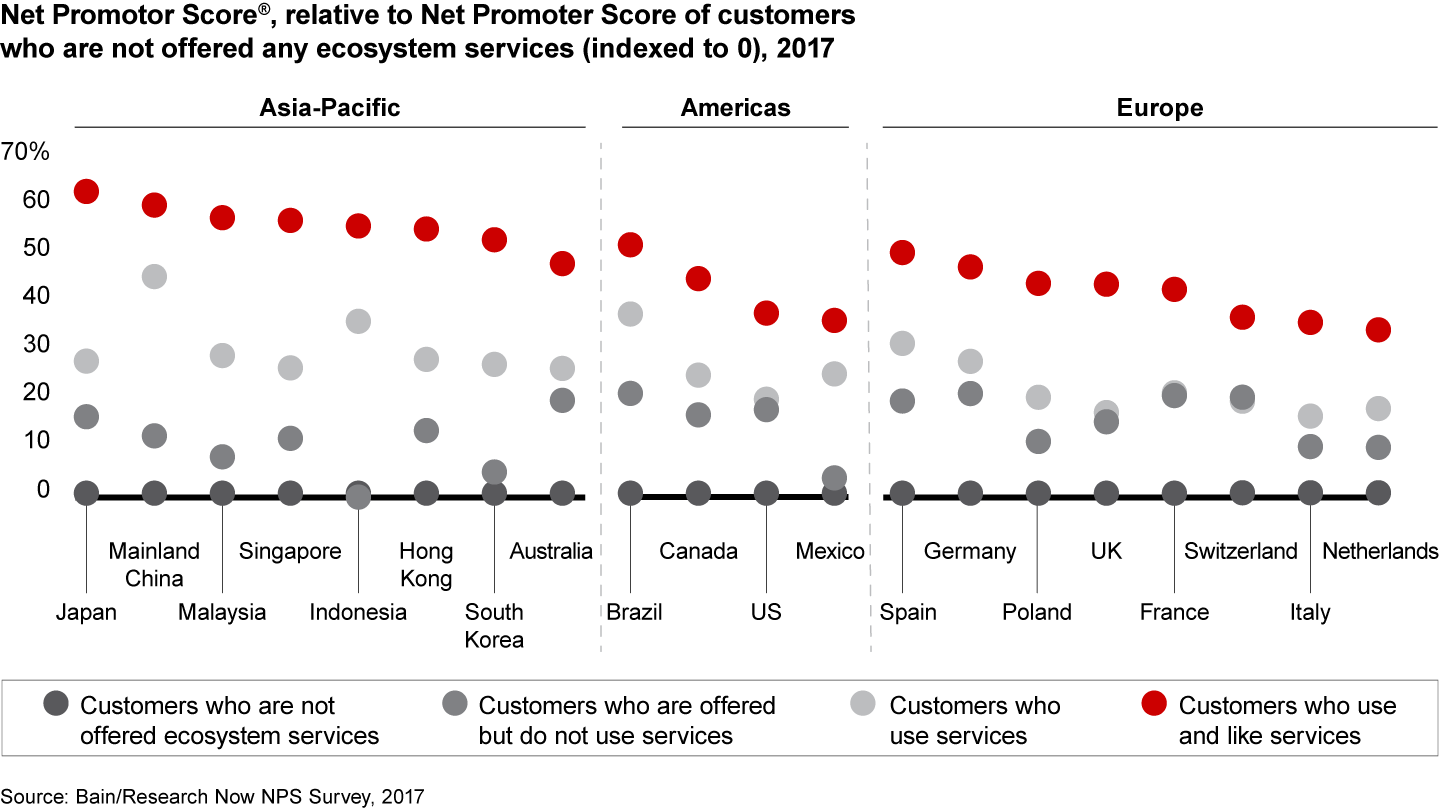

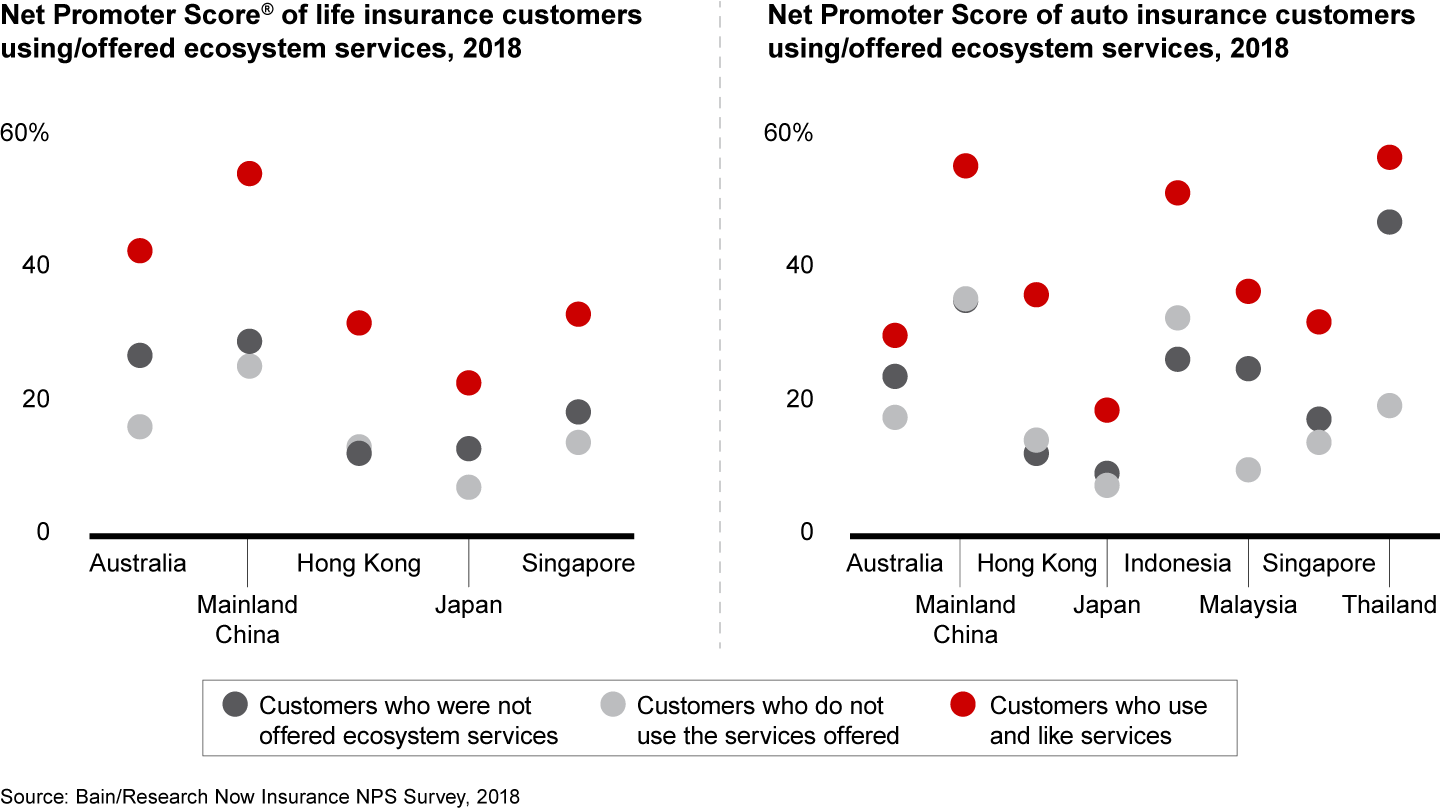

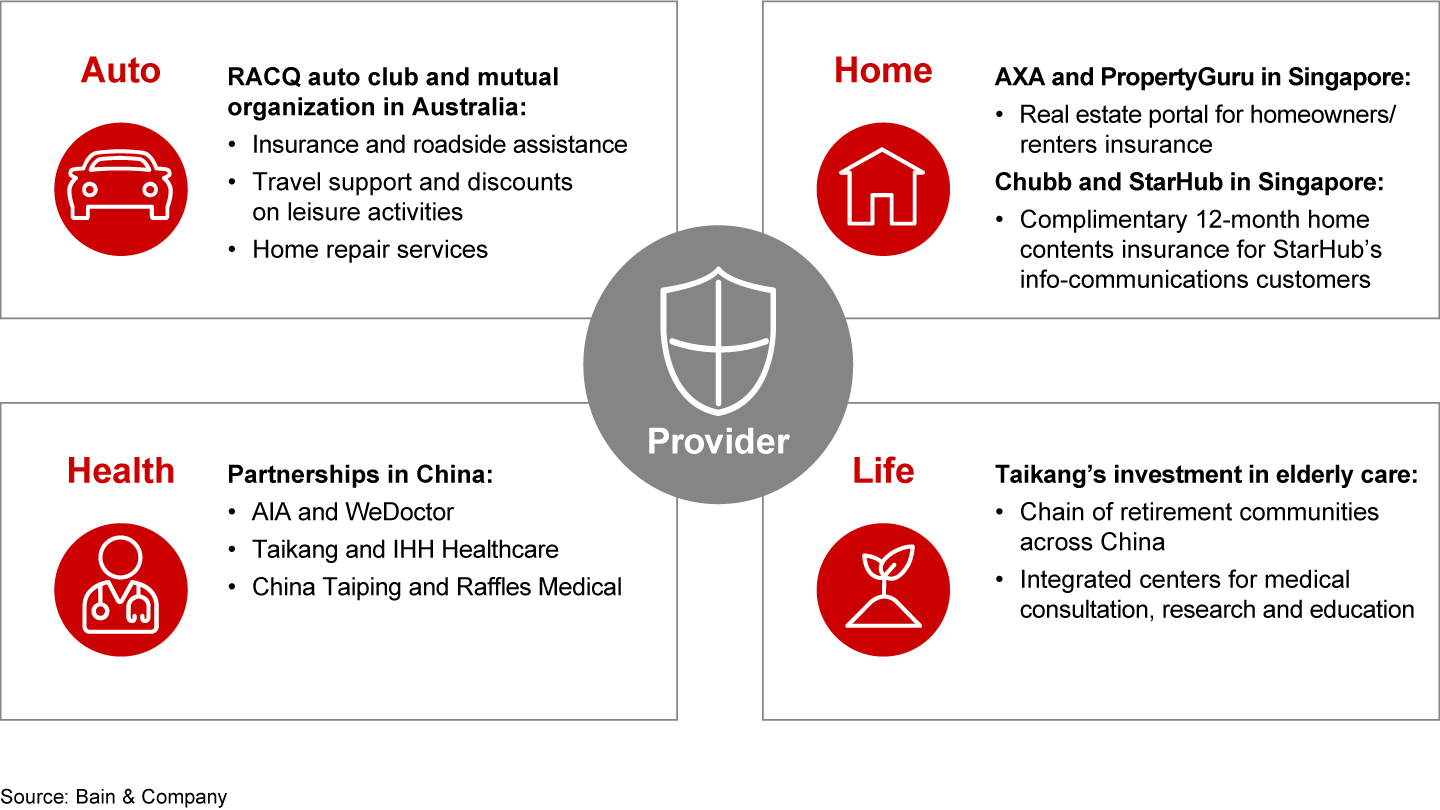

4. M&A opportunities abound in evolving markets
- Acquirers have done about $72 billion in insurance-related M&A deals in Asia-Pacific in the past five years, with many targeting agencies and life insurance carriers.
- Many of the recent large Asia-Pacific insurance transactions have involved the sale of Australian life insurers. Australian banks have been offloading their insurance and wealth management businesses due to lower-than-expected returns and changing regulations.
- Such moves can create buying opportunities for multinational and regional insurers. AIA, for example, is purchasing Commonwealth Bank’s Australian and New Zealand life insurance business. Zurich is acquiring ANZ’s OnePath life insurance business in Australia, as well as an 80% stake in Adira Insurance from Bank Danamon.
- Japanese life insurers have also been active in M&A. Faced with negative core underwriting margins, they’ve turned their attention to generating income from investments.
- Japanese insurers are increasingly pursuing investment returns in industries outside financial services. They are also looking to invest in markets beyond Japan and the US.
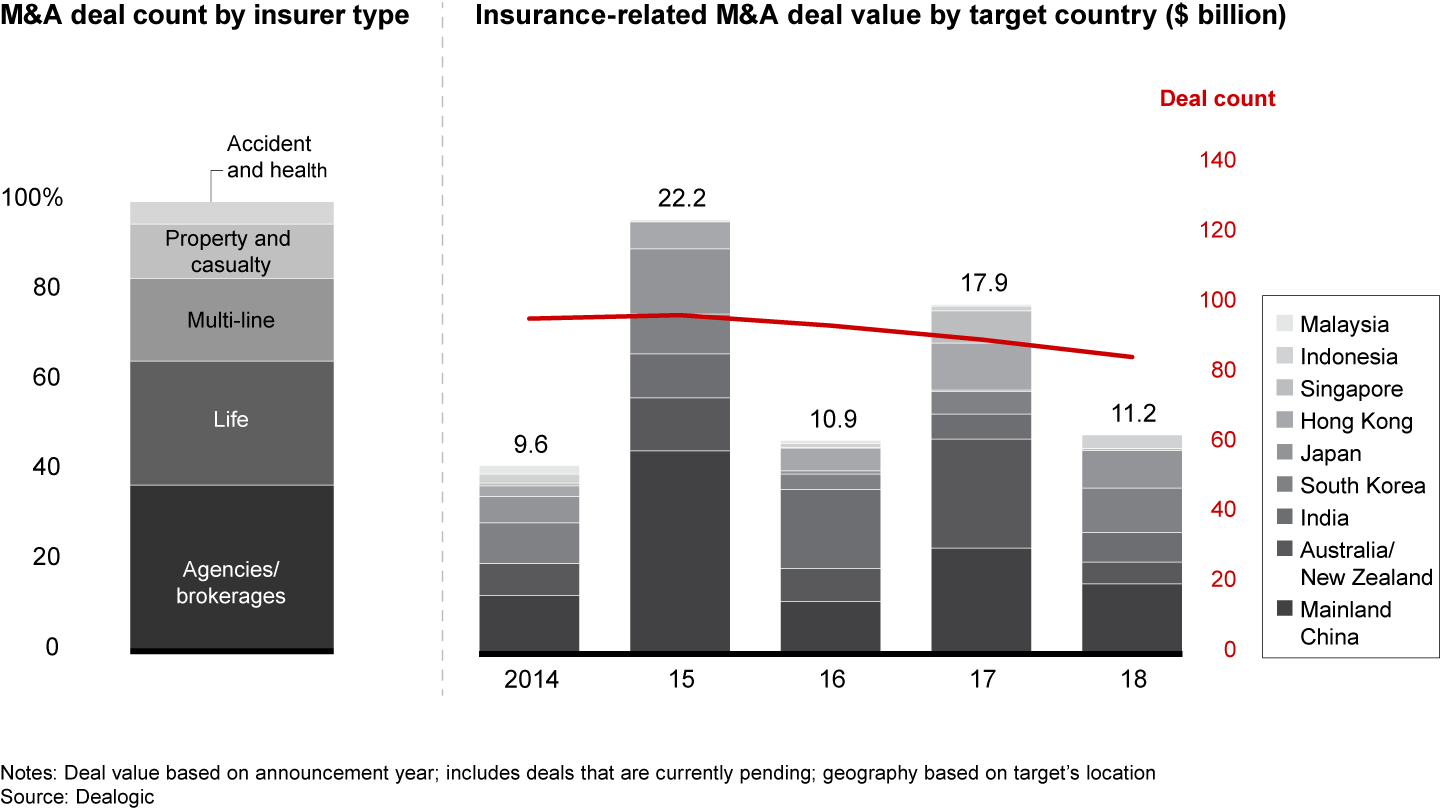



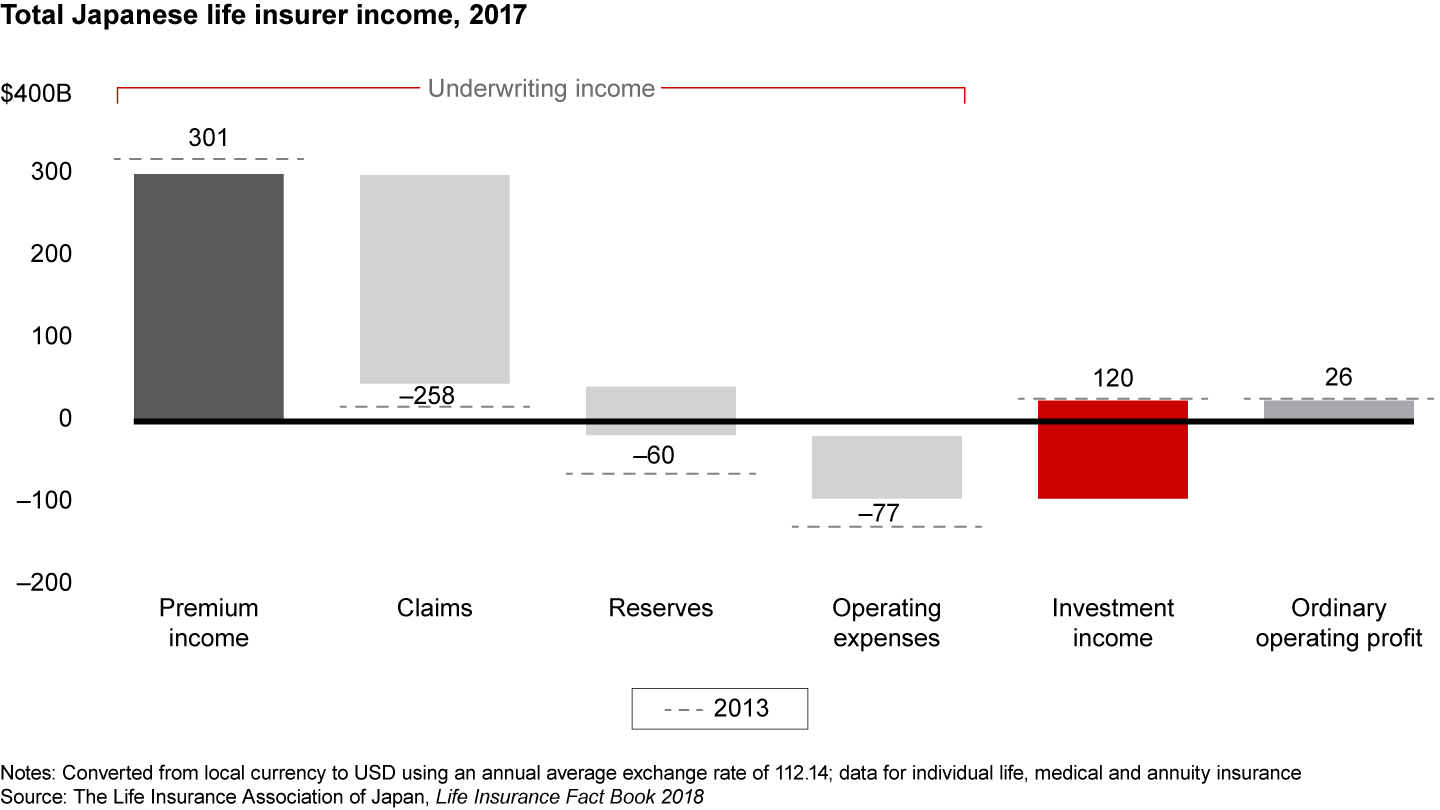



This report was authored by Henrik Naujoks, Harshveer Singh, Mark Judah, Peter Stumbles and Pency Tam. Henrik, Harshveer, Mark and Peter are partners with Bain & Company’s Financial Services practice and are based in Hong Kong, Singapore, Melbourne and Sydney, respectively. Pency is the practice manager with Bain's Financial Services practice in Asia-Pacific; she is based in Sydney.
Net Promoter Score®, Net Promoter System®, Net Promoter® and NPS® are registered trademarks of Bain & Company, Inc., Fred Reichheld and Satmetrix Systems, Inc.